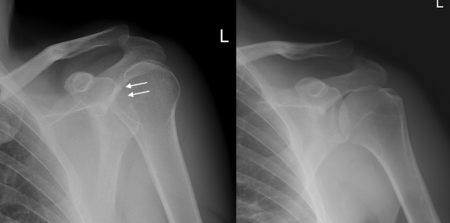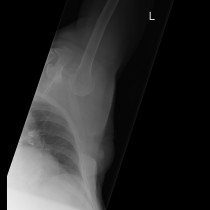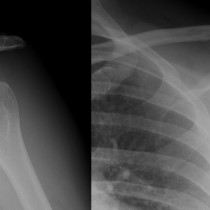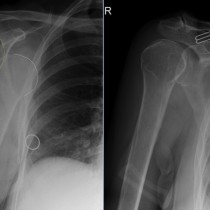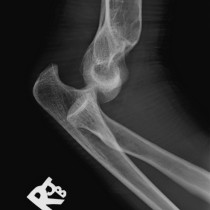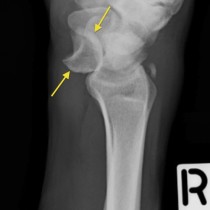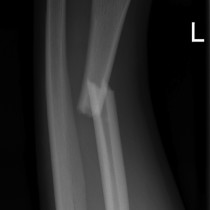Posterior shoulder dislocation
The vast majority of glenohumeral dislocations occur in the anterior direction. Posterior dislocation is rare, making up less than 5% of shoulder dislocations. While anterior dislocation is usually caused by trauma, in posterior dislocation this is less commonly the cause – instead, the characteristic history is that of an epileptic who presents with shoulder pain after a seizure.
In this case, a man is his 40s came to the ED after falling while out jogging. His first shoulder radiograph is on the left and shows the typical appearance of posterior dislocation. Because the humeral head is rotated posteriorly, its relationship to the humeral shaft is likened to a lightbulb. Also present in this example is something called a ‘reverse Hill-Sachs deformity’, which is due to an impaction injury to the anterior aspect of the humeral head as it collides with the posterior aspect of the glenoid during the injury. The resultant depression of the humeral cortex is indicated by the arrows. On the right is his post-reduction radiograph, showing the normal shape of the humeral head that we expect to see on a frontal projection.
These injuries can be difficult to detect clinically, which is unfortunate as they are also frequently difficult to spot on radiographs. In fact, in the majority of patients with posterior shoulder dislocation the diagnosis is delayed, often by weeks, because of this combination of subtle clinical and radiographic findings. The ‘lightbulb’ sign is not always present, and in many cases it will require additional radiographic projections or even a CT to confidently make the diagnosis. The longer the delay in diagnosis, the more difficult it is to reduce the dislocation and some of these patients will require open reduction in theatre.
Complicating this further, in some cases of patients who present with shoulder pain after seizures both shoulders may be dislocated posteriorly. Another potential cause of posterior dislocation of the shoulder is electrocution, in which the mechanism is the same as in seizures (violent muscle contraction), and which can also cause bilateral injury.

